Optimization of On-Grid Hybrid Renewable Energy System: A Case Study on Azad Jammu and Kashmir
Abstract
:1. Introduction
- The optimization algorithm involved in this work is novel as it contradicts with the conventional approaches presented so far in the recent literature. The optimization is performed in two steps. The algorithm proposed for optimal location selection followed by finding optimal sizing. This work selects the optimal locations for placement of RES-based DGs based upon non-conventional variables which are in line with real world power system scenario. These include: (1) considering the availability of primary energy, (2) land for installing DGs, (3) costs incurred upon the installation as well as operation of the DGs, (4) power and energy loss minimization, and (5) availability of power grid. Afterwards, the sizes are optimally found using the HOMER Pro optimization algorithm which contains detailed information about the climate and weather as well as environmental factors. Such systematic and novel approach is missing in the literature, including the mentioned articles.
- The presented work is first of its kind that proposes the design of a viable cost-effective electrification modeling for AJK to make it self-sufficient in terms of energy demands by using indigenous renewable resources.
- This research also provides additional real-world performance optimization for hybrid systems and provides a guideline on energy-efficient, sustainable, and cost-effective design in other regions.
- Determine the effects of renewables on the environment and the economy of AJK.
- To utilize renewable energy sources, such as wind and solar, that can solve the issue of power shortages of region, allowing a continuous power supply.
- To reduce the use of fossil fuels and associated greenhouse gas, while boosting the use of renewable energy.
2. Study Region
2.1. Site Selection
- Availability of primary distribution network.
- Availability of primary energy.
- Load concentration factor [39] in different regions.
2.2. Electrical Load Demand
| Months | Palandari (kWh/m2/day) | Muzaffarabad (kWh/m2/day) |
|---|---|---|
| January | 3.480 | 2.950 |
| February | 4.450 | 3.540 |
| March | 5.500 | 4.550 |
| April | 6.200 | 5.880 |
| May | 6.700 | 6.590 |
| June | 7.600 | 7.460 |
| July | 6.700 | 6.600 |
| August | 6.500 | 5.940 |
| September | 6.100 | 5.700 |
| October | 5.800 | 4.890 |
| November | 4.400 | 3.690 |
| December | 3.700 | 2.790 |
3. HOMER-Based HRES Design
4. Cost and Performance Description of Selected RES
4.1. PV Array
4.2. Wind Turbine
4.3. Hydro Turbine
4.4. Inverter
4.5. Grid Extension
5. Results and Discussion
5.1. Simulation System Design
5.2. Analysis Case Studies
- Case 1: PV/DGen/Grid.
- Case 2: Wind/Hydro/DGen.
- Case 3: PV/Wind/Battery.
- Case 4: PV/Wind/Hydro/Grid.
5.3. Cost Analysis
5.4. GHG Emissions
5.5. Electrical System Performance Evaluation
5.6. Economic Viability of Proposed HRES
6. Conclusions
- The selected sites have a tremendous potential for renewables. The climate, geography, and habitat provide the site with enough potential to exploit the available renewable resources.
- PV/Wind/Hydro mix can provide reliable electricity supply with 0% unmet power demand.
- Switching to an on-grid system architecture eliminates the need for batteries, reducing the various cost significantly.
- Compared to other HRES and standalone power system, the proposed system is cheaper with exceptional return on investment of 69.5%. The system is repaid in a noticeably short period of 1.36 years with a higher internal rate of return of 74.2%.
- With 0% surplus of power, the proposed system is extremely viable.
- The proposed HRES has a renewable factor of 86.45% and reduces overall GHG gases to 69.1%.
- With the proposed HRES, the total losses is reduced by 22.7% and total line infeed from external grid is reduced by 33.5%. Moreover, the overall voltage profile of all the network is improved as well.
Author Contributions
Funding
Conflicts of Interest
Abbreviations
| Capital cost of grid extension | |
| Total NPC of the standalone power system in USD | |
| O&M cost of grid extension | |
| Cost of power from the grid | |
| Capital recovery factor | |
| Break-even grid extension distance | |
| Load demand at time t | |
| Total annual electrical energy demand | |
| Total available power generation at time t | |
| Fuel consumption | |
| Emission factor | |
| Grid net purchase | |
| Net grid purchases | |
| n | Interest rate |
| Electric power demand | |
| Power generated using renewable | |
| Electric power exchange with the grid | |
| Power generation from hydropower system | |
| Power generation from PV system | |
| Total power generation from proposed HRES | |
| Unmet load in hour (h) | |
| Power generation from wind turbine system | |
| Total net present cost | |
| y | Lifetime of project in years |
| AJK | Azad Jammu and Kashmir |
| CC | capital Cost |
| COE | Cost of Energy |
| DGen | Diesel Generator |
| EE | Excess Energy |
| EP | Electrical Power |
| GHG | Green House Gas |
| HOMER | Hybrid Optimization of Multiple Energy Resources |
| HRES | Hybrid Renewable Energy System |
| IC | Initial Cost |
| kWh | Kilo Watt Hour |
| LPSP | Loss of Power Supply Probability |
| MW | Mega Watt |
| MWh | Mega Watt Hour |
| MZD | Muzaffarabad |
| NASA | National Aeronautics and Space Administration |
| NPC | Net Present Cost |
| NREL | National Renewable Energy Laboratory |
| O&M | Operation and Management |
| PKR | Pakistani Rupee |
| PS | Power System |
| PV | Photovoltaic |
| RC | Replacement Costs |
| RE | Renewable Energy |
| ROI | Return on Investment |
| RPS | Renewable Power System |
| SV | Salvage Value |
| USD | United States Dollar |
References
- Shahzad, M.; Ahmad, I.; Gawlik, W.; Palensky, P. Active power loss minimization in radial distribution networks with analytical method of simultaneous optimal DG sizing. In Proceedings of the 2016 IEEE International Conference on Industrial Technology (ICIT), Taipei, Taiwan, 14–17 March 2016; pp. 470–475. [Google Scholar]
- Shahzad, M.; Gawlik, W.; Palensky, P. Voltage quality index based method to quantify the advantages of optimal DG placement. In Proceedings of the 2016 Eighteenth International Middle East Power Systems Conference (MEPCON), Cairo, Egypt, 27–29 December 2016; pp. 759–764. [Google Scholar]
- Shahzad, M.; Akram, W.; Arif, M.; Khan, U.; Ullah, B. Optimal siting and sizing of distributed generators by strawberry plant propagation algorithm. Energies 2021, 14, 1744. [Google Scholar] [CrossRef]
- Helmi, A.M.; Carli, R.; Dotoli, M.; Ramadan, H.S. Efficient and sustainable reconfiguration of distribution networks via metaheuristic optimization. IEEE Trans. Autom. Sci. Eng. 2021, 19, 82–98. [Google Scholar] [CrossRef]
- Muhammad, M.A.; Mokhlis, H.; Naidu, K.; Amin, A.; Franco, J.F.; Othman, M. Distribution network planning enhancement via network reconfiguration and DG integration using dataset approach and water cycle algorithm. J. Mod. Power Syst. Clean Energy 2019, 8, 86–93. [Google Scholar] [CrossRef]
- Carli, R.; Cavone, G.; Pippia, T.; De Schutter, B.; Dotoli, M. Robust Optimal Control for Demand Side Management of Multi-Carrier Microgrids. IEEE Trans. Autom. Sci. Eng. 2022. early access. [Google Scholar] [CrossRef]
- Khan, I.A.; Khan, M.R.; Baig, M.H.A.; Hussain, Z.; Hameed, N.; Khan, J.A. Assessment of forest cover and carbon stock changes in sub-tropical pine forest of Azad Jammu & Kashmir (AJK), Pakistan using multi-temporal Landsat satellite data and field inventory. PloS ONE 2020, 15, e0226341. [Google Scholar]
- Mirza, U.K.; Maroto-Valer, M.M.; Ahmad, N. Status and outlook of solar energy use in Pakistan. Renew. Sustain. Energy Rev. 2003, 7, 501–514. [Google Scholar] [CrossRef]
- Adnan, S.; Hayat Khan, A.; Haider, S.; Mahmood, R. Solar energy potential in Pakistan. J. Renew. Sustain. Energy 2012, 4, 032701. [Google Scholar] [CrossRef]
- International Hydropower Association. 2022. Available online: https://www.hydropower.org/country-profiles/pakistan (accessed on 5 April 2022).
- Govt. of Azad Jammu & Kashmir. Hydropower Resources in AJK, Pakistan. 2022. Available online: https://www.ajk.gov.pk/gallery/hydro-power (accessed on 5 April 2022).
- Ahmed, M.A.; Ahmed, F.; Akhtar, M.W. Assessment of wind power potential for coastal areas of Pakistan. Turk. J. Phys. 2006, 30, 127–135. [Google Scholar]
- Uddin, W.; Khan, B.; Shaukat, N.; Majid, M.; Mujtaba, G.; Mehmood, A.; Ali, S.; Younas, U.; Anwar, M.; Almeshal, A.M. Biogas potential for electric power generation in Pakistan: A survey. Renew. Sustain. Energy Rev. 2016, 54, 25–33. [Google Scholar] [CrossRef]
- Finance Division, Govt. of Pakistan. Pakistan Economic Survey 2012-13. 2022. Available online: http://www.finance.gov.pk/survey_1213.html (accessed on 5 April 2022).
- Zia, U.U.R.; Ur Rashid, T.; Nazir Awan, W.; Ahmed, T.B.; Siddique, M.A.; Habib, M.F.; Asid, R.M. Technological Assessment of Bio Energy Production through Livestock Waste in Azad Jammu and Kashmir (AJK). In Proceedings of the 2019 International Conference on Electrical Communication and Computer Engineering (ICECCE), Swat, Pakistan, 24–25 July 2019; pp. 1–5. [Google Scholar]
- Khan, M.A.; Khan, J.A.; Ali, Z.; Ahmad, I.; Ahmad, M.N. The challenge of climate change and policy response in Pakistan. Environ. Earth Sci. 2016, 75, 1–16. [Google Scholar] [CrossRef]
- Akikur, R.K.; Saidur, R.; Ping, H.W.; Ullah, K.R. Comparative study of stand-alone and hybrid solar energy systems suitable for off-grid rural electrification: A review. Renew. Sustain. Energy Rev. 2013, 27, 738–752. [Google Scholar] [CrossRef]
- Tahir, M.U.R.; Amin, A.; Baig, A.A.; Manzoor, S.; ul Haq, A.; Asgha, M.A.; Khawaja, W.A.G. Design and optimization of grid Integrated hybrid on-site energy generation system for rural area in AJK-Pakistan using HOMER software. AIMS Energy 2021, 9, 1113–1135. [Google Scholar] [CrossRef]
- Iqbal, S.; Jan, M.U.; Rehman, A.U.; Shafique, A.; Rehman, H.U.; Aurangzeb, M. Feasibility Study and Deployment of Solar Photovoltaic System to Enhance Energy Economics of King Abdullah Campus, University of Azad Jammu and Kashmir Muzaffarabad, AJK Pakistan. IEEE Access 2022, 10, 5440–5455. [Google Scholar] [CrossRef]
- Chambon, C.L.; Karia, T.; Sandwell, P.; Hallett, J.P. Techno-economic assessment of biomass gasification-based mini-grids for productive energy applications: The case of rural India. Renew. Energy 2020, 154, 432–444. [Google Scholar] [CrossRef]
- Kazmi, S.W.S.; Sheikh, M.I. Hybrid geothermal–PV–wind system for a village in Pakistan. SN Appl. Sci. 2019, 1, 1–15. [Google Scholar] [CrossRef] [Green Version]
- Acevedo-Arenas, C.Y.; Correcher, A.; Sánchez-Díaz, C.; Ariza, E.; Alfonso-Solar, D.; Vargas-Salgado, C.; Petit-Suárez, J.F. MPC for optimal dispatch of an AC-linked hybrid PV/wind/biomass/H2 system incorporating demand response. Energy Convers. Manag. 2019, 186, 241–257. [Google Scholar] [CrossRef]
- Bagheri, M.; Delbari, S.H.; Pakzadmanesh, M.; Kennedy, C.A. City-integrated renewable energy design for low-carbon and climate-resilient communities. Appl. Energy 2019, 239, 1212–1225. [Google Scholar] [CrossRef]
- Krishnamoorthy, M.; Periyanayagam, A.D.V.R.; Santhan Kumar, C.; Praveen Kumar, B.; Srinivasan, S.; Kathiravan, P. Optimal sizing, selection, and techno-economic analysis of battery storage for PV/BG-based hybrid rural electrification system. IETE J. Res. 2020, 1–16. [Google Scholar] [CrossRef]
- Sperstad, I.B.; Korpås, M. Energy storage scheduling in distribution systems considering wind and photovoltaic generation uncertainties. Energies 2019, 12, 1231. [Google Scholar] [CrossRef] [Green Version]
- Bekele, G.; Palm, B. Feasibility study for a standalone solar–wind-based hybrid energy system for application in Ethiopia. Appl. Energy 2010, 87, 487–495. [Google Scholar] [CrossRef]
- Barsoum, N.; Yiin, W.Y.; Ling, T.K.; Goh, W. Modeling and cost simulation of stand-alone solar and biomass energy. In Proceedings of the 2008 Second Asia International Conference on Modelling & Simulation (AMS), Kuala Lumpur, Malaysia, 13–15 May 2008; pp. 1–6. [Google Scholar]
- Nfah, E.; Ngundam, J.; Vandenbergh, M.; Schmid, J. Simulation of off-grid generation options for remote villages in Cameroon. Renew. Energy 2008, 33, 1064–1072. [Google Scholar] [CrossRef]
- Lal, D.K.; Dash, B.B.; Akella, A. Optimization of PV/wind/micro-hydro/diesel hybrid power system in HOMER for the study area. Int. J. Electr. Eng. Inform. 2011, 3, 307. [Google Scholar]
- Rehman, S.; Habib, H.U.R.; Wang, S.; Büker, M.S.; Alhems, L.M.; Al Garni, H.Z. Optimal design and model predictive control of standalone HRES: A real case study for residential demand side management. IEEE Access 2020, 8, 29767–29814. [Google Scholar] [CrossRef]
- Odou, O.D.T.; Bhandari, R.; Adamou, R. Hybrid off-grid renewable power system for sustainable rural electrification in Benin. Renew. Energy 2020, 145, 1266–1279. [Google Scholar] [CrossRef]
- Steinke, F.; Wolfrum, P.; Hoffmann, C. Grid vs. storage in a 100% renewable Europe. Renew. Energy 2013, 50, 826–832. [Google Scholar] [CrossRef]
- Alam, M.; Bhattacharyya, S. Decentralized renewable hybrid mini-grids for sustainable electrification of the off-grid coastal areas of Bangladesh. Energies 2016, 9, 268. [Google Scholar] [CrossRef] [Green Version]
- Ahmadigorji, M.; Abbaspour, A.; Rajabi-Ghahnavieh, A.; Fotuhi-Firuzabad, M. Optimal DG placement in distribution systems using cost/worth analysis. World Acad. Sci. Eng. Technol. 2009, 49, 746–753. [Google Scholar]
- Porkar, S.; Poure, P.; Abbaspour-Tehrani-fard, A.; Saadate, S. Optimal allocation of distributed generation using a two-stage multi-objective mixed-integer-nonlinear programming. Eur. Trans. Electr. Power 2011, 21, 1072–1087. [Google Scholar] [CrossRef]
- Mashhour, M.; Golkar, M.; Tafreshi, S.M. Optimal sizing and siting of distributed generation in radial distribution network: Comparison of unidirectional and bidirectional power flow scenario. In Proceedings of the 2009 IEEE Bucharest PowerTech, Bucharest, Romania, 28 June–2 July 2009; pp. 1–8. [Google Scholar]
- Hosseini, S.; Askarian Abyaneh, H.; Sadeghi, S.; Razavi, F.; Karami, M. Optimal Sizing and Siting of DG Resources at 63kV/20kV Substations Considering the Effect of Earthquake on Technical and Economic Parameters. Iran. J. Sci. Technol. Trans. Electr. Eng. 2015, 39, 133–153. [Google Scholar]
- Electricity Department, Govt. of AJK. Electricity Generation Report of AJK. 2022. Available online: https://electricity.ajk.gov.pk/ (accessed on 5 April 2022).
- Shahzad, M.; Ahmad, I.; Gawlik, W.; Palensky, P. Load concentration factor based analytical method for optimal placement of multiple distribution generators for loss minimization and voltage profile improvement. Energies 2016, 9, 287. [Google Scholar] [CrossRef] [Green Version]
- Environment Protection Agency, Govt. of AJK. Environment Protection Agency of AJK. 2022. Available online: https://epa.ajk.gov.pk/ (accessed on 5 April 2022).
- National Aeronautics and Space Administration, Science. Weather and Atmospheric Dynamics Focus Area. 2022. Available online: https://science.nasa.gov/earth-science/focus-areas/earth-weather (accessed on 5 April 2022).
- Accu Weather. Online Weather. 2022. Available online: http://www.accuweather.com (accessed on 5 April 2022).
- World Weather Online for MZD. Online Weather of Muzaffarabad, AJK. 2022. Available online: https://www.worldweatheronline.com/muzaffarabad-15day-weather-chart/azad-kashmir/pk.aspx (accessed on 5 April 2022).
- World Weather Online for Palandri. Online Weather of Palandri, AJK. 2022. Available online: https://www.worldweatheronline.com/palandri-15day-weather-chart/azad-kashmir/pk.aspx (accessed on 5 April 2022).
- Mahmood, R.; Jia, S. Assessment of impacts of climate change on the water resources of the transboundary Jhelum River basin of Pakistan and India. Water 2016, 8, 246. [Google Scholar] [CrossRef] [Green Version]
- Bhatt, A.; Sharma, M.; Saini, R. Feasibility and sensitivity analysis of an off-grid micro hydro–photovoltaic–biomass and biogas–diesel–battery hybrid energy system for a remote area in Uttarakhand state, India. Renew. Sustain. Energy Rev. 2016, 61, 53–69. [Google Scholar] [CrossRef]
- Rehman, S.; Natrajan, N.; Mohandes, M.; Alhems, L.M.; Himri, Y.; Allouhi, A. Feasibility study of hybrid power systems for remote dwellings in Tamil Nadu, India. IEEE Access 2020, 8, 143881–143890. [Google Scholar] [CrossRef]
- Wind Turbines Models. Specifications: Norvento nED 100-24. 2022. Available online: https://en.wind-turbine-models.com/turbines/1804-norvento-ned-100-24 (accessed on 5 April 2022).
- Anemio Services. Cost Benefit Analysis of Wind Turbines. 2022. Available online: http://anemoiservices.com/industry-news/how-much-money-does-a-wind-turbine-produce-from-electricity-it-generates/ (accessed on 5 April 2022).
- Arif, M.; Shahzad, M.; Saleem, J.; Malik, W.; Majid, A. Single Conversion Stage Three Port High Gain Converter for PV Integration with DC Microgrid. Elektron. Elektrotechnika 2020, 26, 69–78. [Google Scholar] [CrossRef]
- Arif, M.; Shahzad, M.; Li, Q.; Saleem, J.; Aslam, M.S.; Majid, A. Single Magnetic Element-Based High Step-Up Converter for Energy Storage and Photovoltaic System with Reduced Device Count. Complexity 2020, 2020, 5892190. [Google Scholar] [CrossRef]
- National Transmission and Dispatch Company, Pakistan. Electrical Power Transmission Network of Pakistan. 2022. Available online: https://ntdc.gov.pk/ (accessed on 5 April 2022).
- Shahzad, M.; Shafiullah, Q.; Akram, W.; Arif, M.; Ullah, B. Reactive Power Support in Radial Distribution Network Using Mine Blast Algorithm. Elektron. Elektrotechnika 2021, 27, 33–40. [Google Scholar] [CrossRef]
- Bilal, M.; Shahzad, M.; Arif, M.; Ullah, B.; Hisham, S.B.; Ali, S.S.A. Annual Cost and Loss Minimization in a Radial Distribution Network by Capacitor Allocation Using PSO. Appl. Sci. 2021, 11, 11840. [Google Scholar] [CrossRef]
- Iweh, C.D.; Gyamfi, S.; Tanyi, E.; Effah-Donyina, E. Distributed Generation and Renewable Energy Integration into the Grid: Prerequisites, Push Factors, Practical Options, Issues and Merits. Energies 2021, 14, 5375. [Google Scholar] [CrossRef]
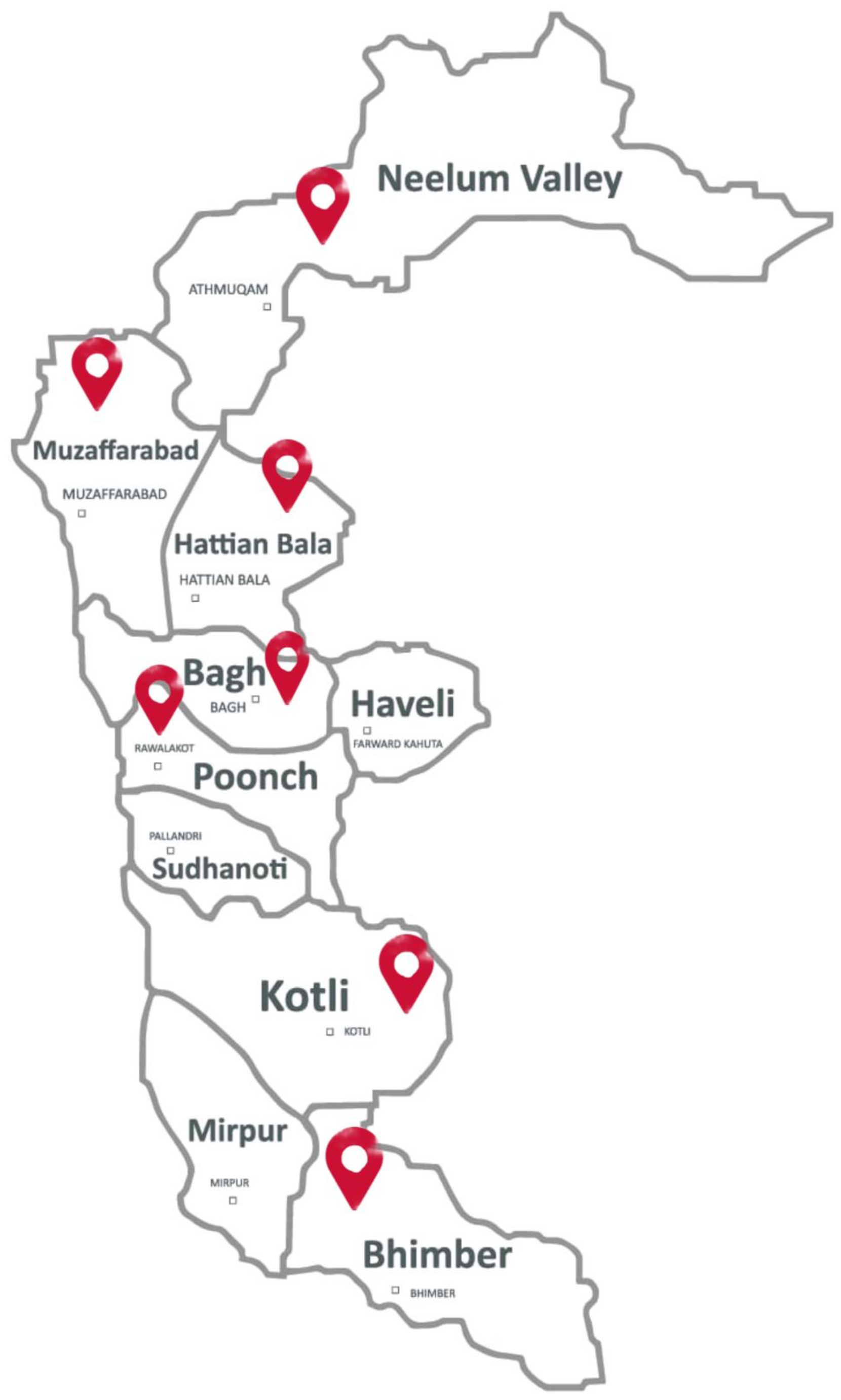
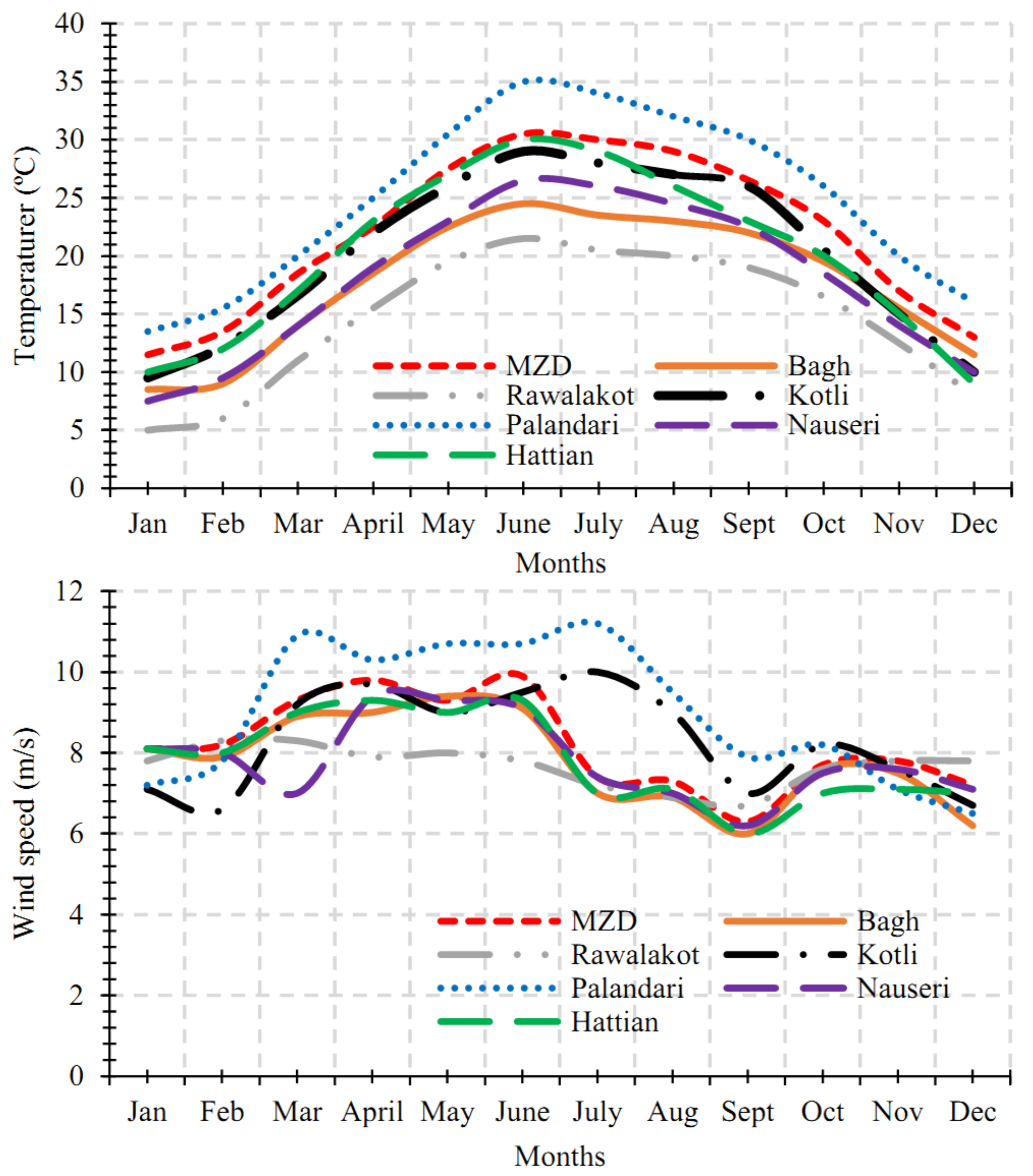
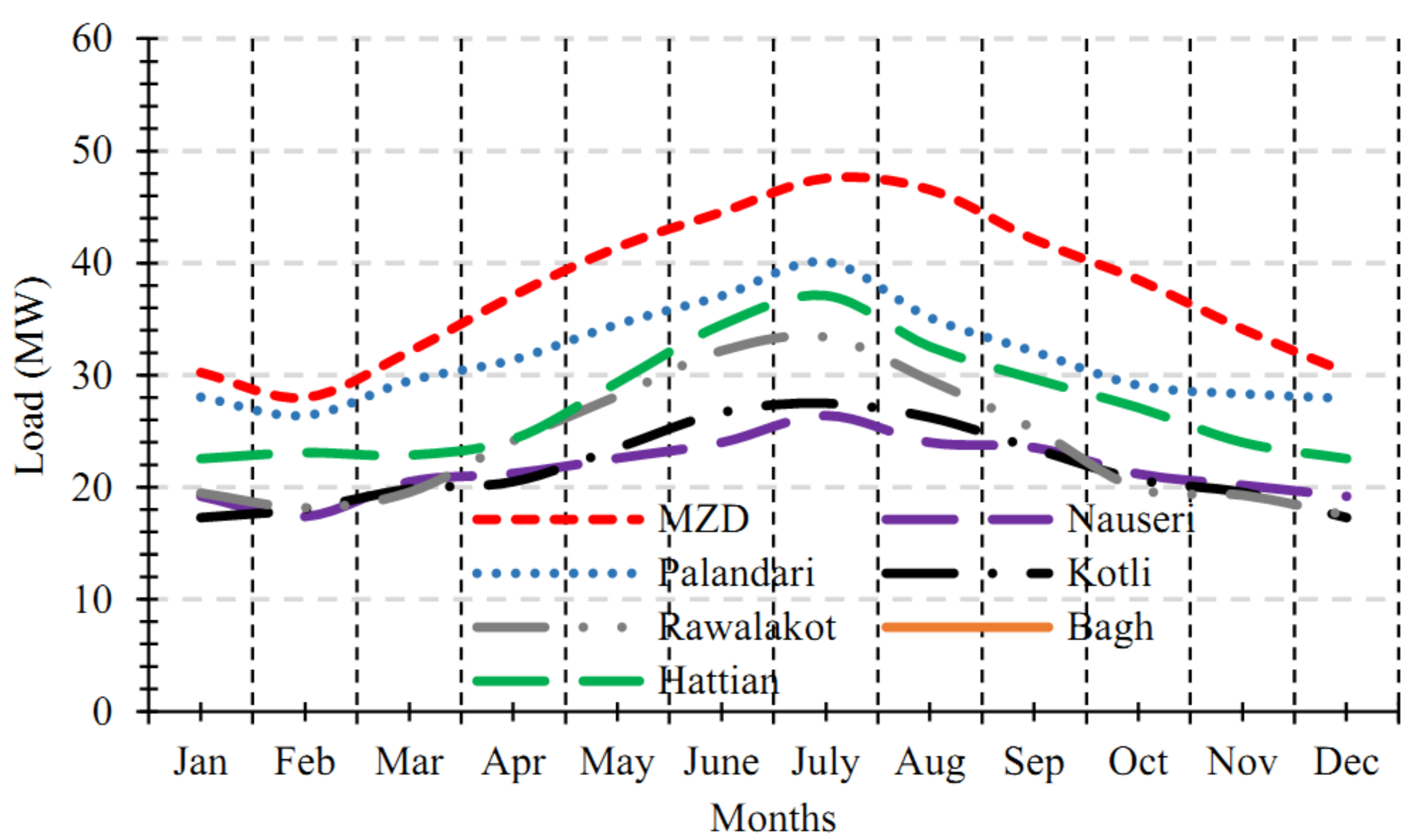

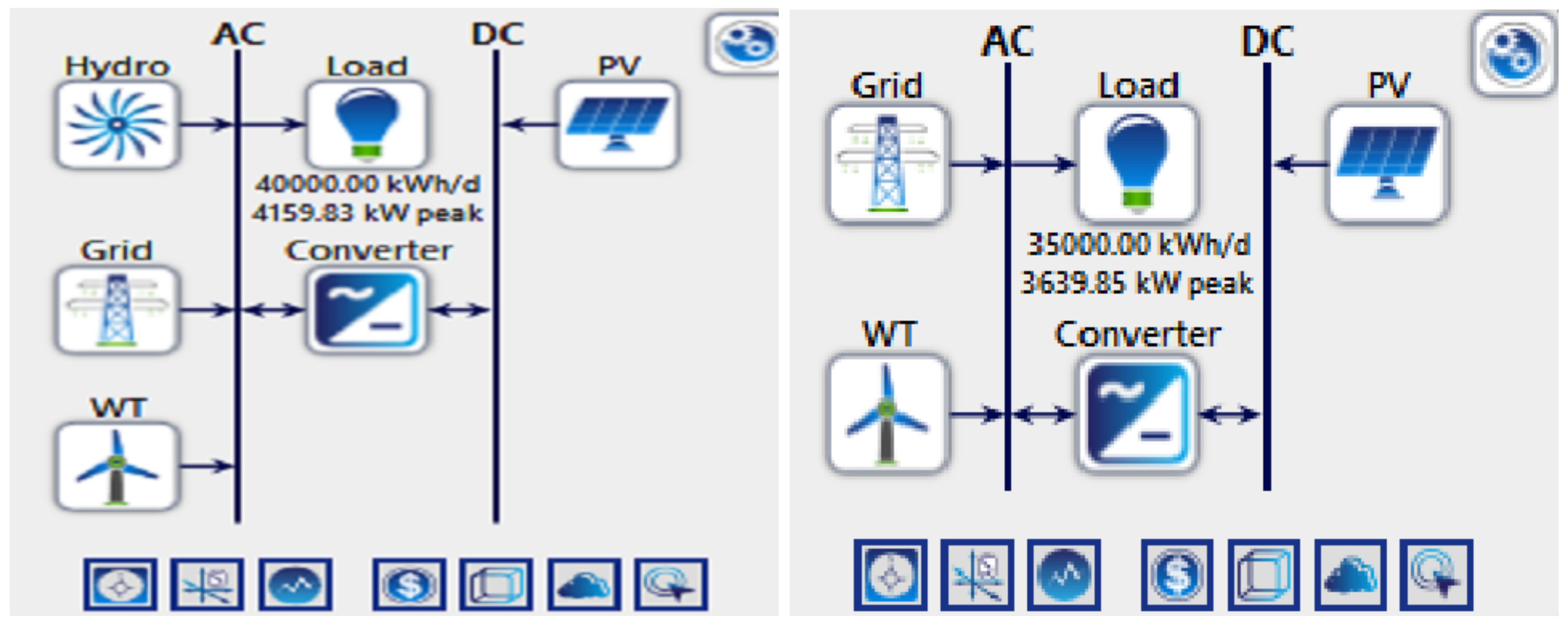
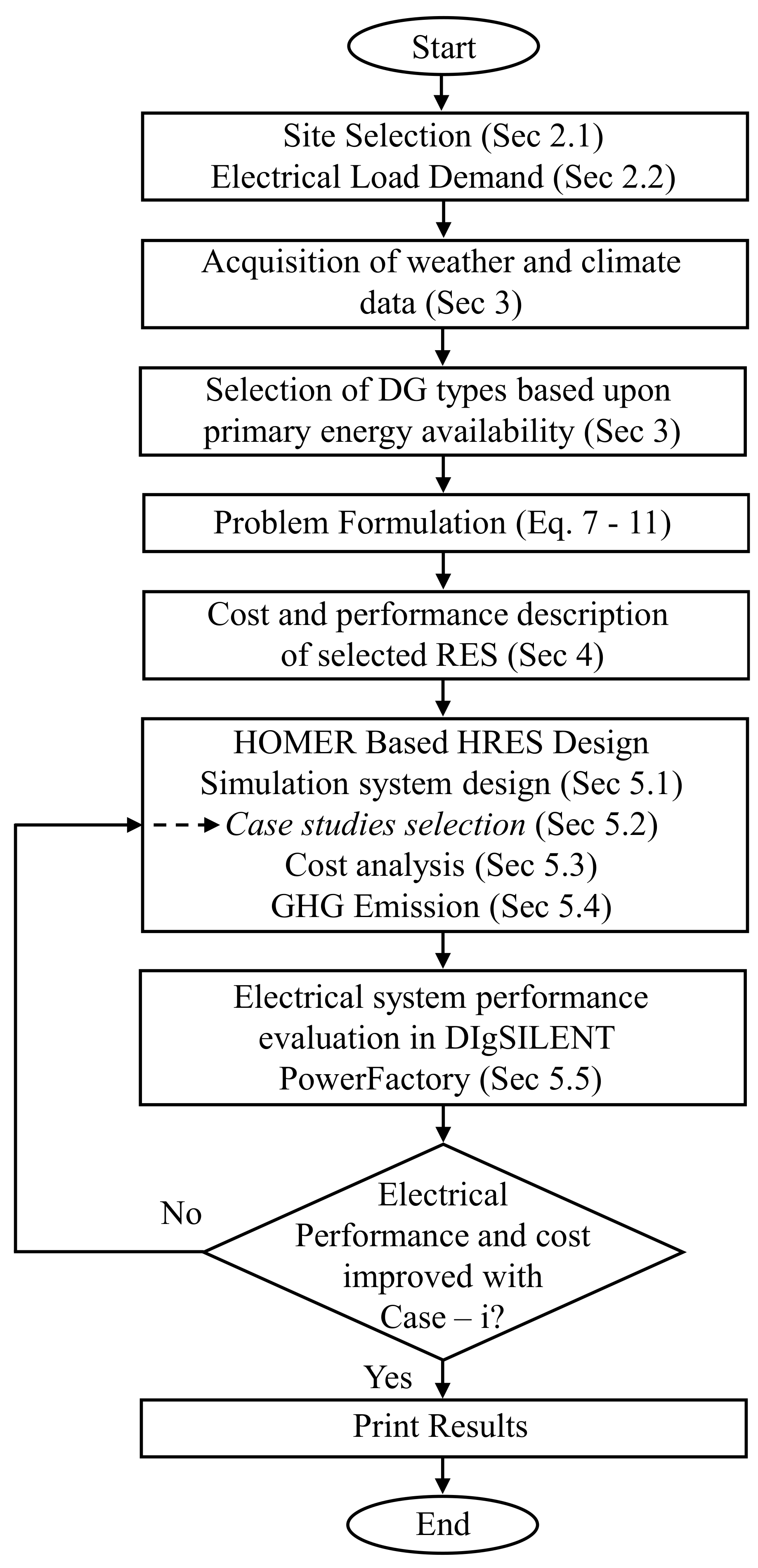
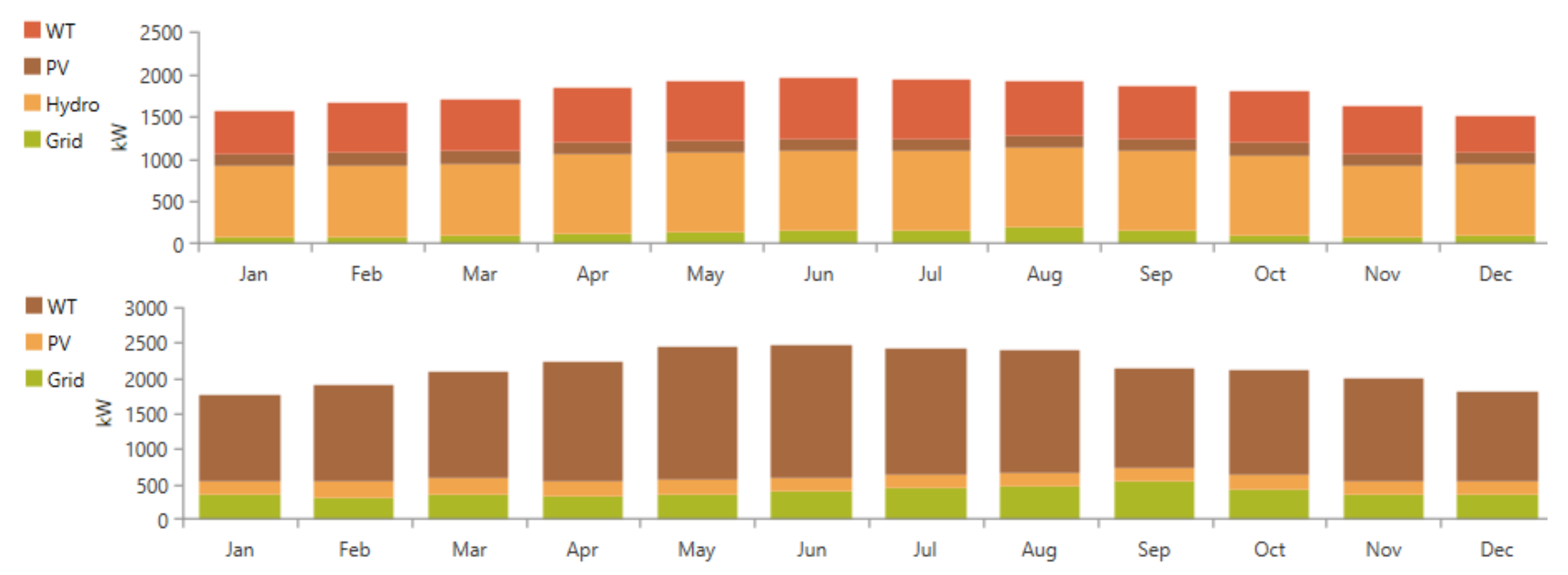
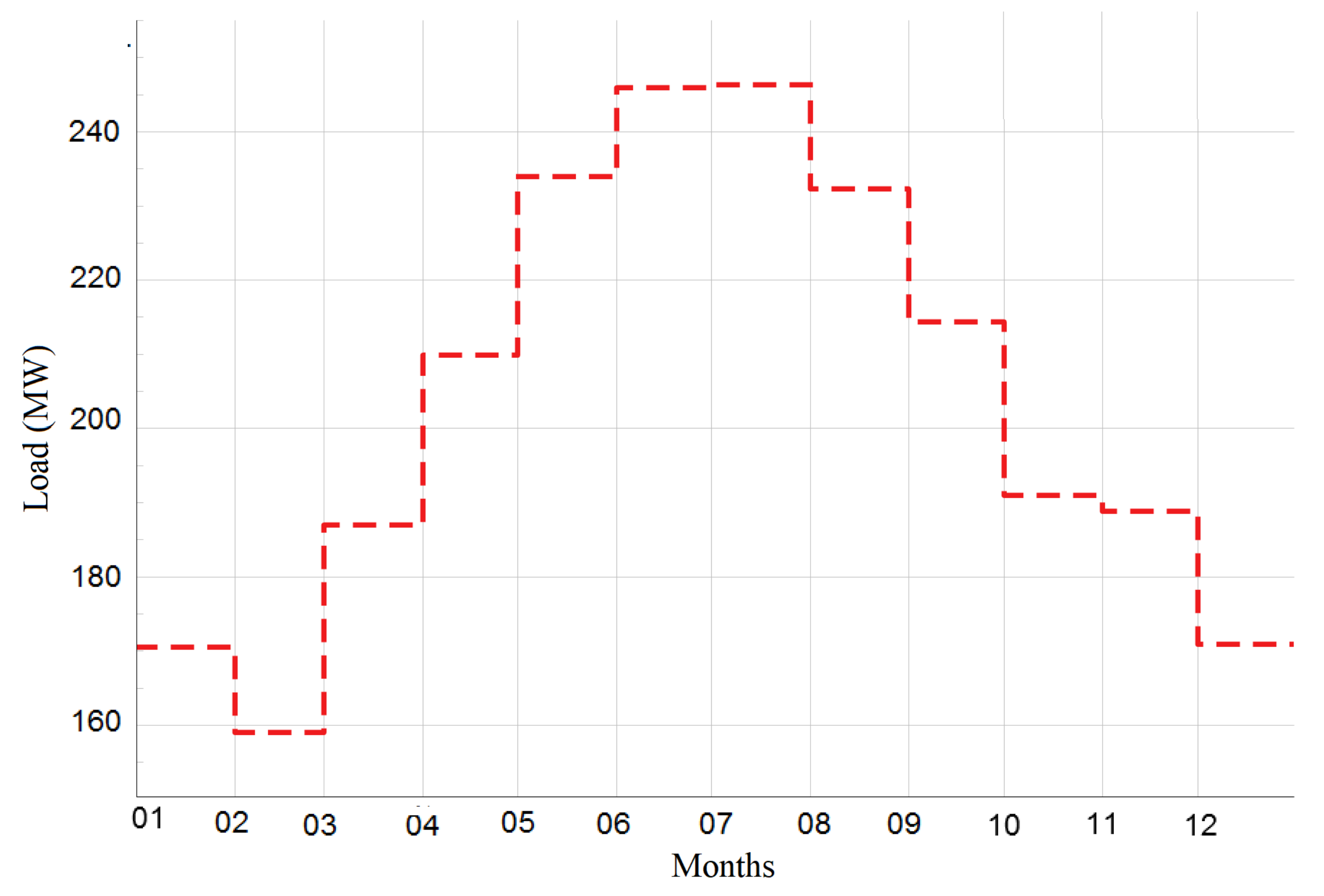

| Item | PV Panel [47] | Wind Turbine [48,49] | Hydro Turbine [18] |
|---|---|---|---|
| Manufacturer | Sharp-ND-500 W | Norvento nED100 (IEC-IIIA) | Kinetic Turbine (HKT) |
| Rated Power (kW) | 0.5 | 100 | 1600 |
| Initial cost (×) | 1.5 | 40 | 500 |
| Replace. cost (×) | 1.2 | 30 | 250 |
| Maintenance cost ($) | 5 | 500 | 500 |
| Lifetime (years) | 25 | 25 | 20 |
| Efficiency (%) | 22 | 70 | 90 |
| Pipe losses (%) | — | — | 15 |
| Operating Temp. | 25 °C | — | — |
| Rated speed (m/s) | — | 10.0 | — |
| Cut-out-speed | — | 20.0 | — |
| Rated speed (m/s) | — | 10.0 | — |
| Rotor diameter (m) | — | 22, 23 | 24 |
| Architecture | Cost | System | |||||||||||
|---|---|---|---|---|---|---|---|---|---|---|---|---|---|
| Loc | PV (MW) | Wind (GWh) | Gen (MW) | Hydro (MW) | Batt (MWh) | Grid (MWh) | Conv. (MW) | COE ($/kWh) | NPC (M$) | IC (M$) | RF (%) | EE (%) | |
| Purchase | Sale | ||||||||||||
| Case 1: PV/Dies-gen/Grid | |||||||||||||
| Loc-1 | 40 | — | 2.4 | — | — | 5186.7 | 29304.4 | 9.57 | 0.152 | 8.6 | 14.9 | 85.2 | 55.9 |
| Loc-2 | 11.67 | — | 1 | — | — | 6018.5 | 20552.4 | 16.38 | 0.046 | 2.69 | 8.41 | 81.9 | 28 |
| Case 2: Wind/Dies-gen/Hydro | |||||||||||||
| Loc-1 | — | 108.63 | 4.1 | 1.06 | — | — | — | — | 0.158 | 35.7 | 11.6 | 79.2 | 88.5 |
| Loc-2 | — | 97.15 | 4.6 | 1.06 | — | — | — | — | 0.204 | 38.3 | 12.1 | 74 | 85.5 |
| Case 3: PV/Wind/Battery | |||||||||||||
| Loc-1 | 7.87 | 42.72 | — | — | 29.2 | — | — | 3.61 | 0.140 | 31.7 | 16.0 | 100 | 78.4 |
| Loc-2 | 9.12 | 24.88 | — | — | 37.1 | — | — | 4.82 | 0.171 | 32.4 | 17.8 | 100 | 67.6 |
| Case 4: PV/Wind/Hydro/Grid | |||||||||||||
| Loc-1 | 0.70 | 9.87 | — | 1.06 | — | 1878.8 | 6678.1 | 0.61 | 0.00338 | 0.93 | 1.89 | 91.1 | 0 |
| Loc-2 | 0.70 | 13.63 | — | — | — | 3402.8 | 5883.1 | 0.63 | 0.00815 | 2.69 | 1.60 | 81.8 | 0.103 |
| Loc | Purchase (MWh) | Cost ( | Sales (kWh) | Revenue () |
|---|---|---|---|---|
| Loc-1 | 1878.8 | 187.8 | 6678.1 | 333.9 |
| Loc-2 | 3402.8 | 340.2 | 5883.1 | 294.1 |
| Total | 5281.7 | 528.1 | 12,561.2 | 628.06 |
| Saving | 99960 $ | |||
| Metric | Value |
|---|---|
| Present worth ($) | 12,462,415 |
| Annual worth ($/year) | 840,080 |
| Return on investment (%) | 69.5 |
| Internal rate of return (%) | 74.2 |
| Simple payback (year) | 1.36 |
| Discounted payback (year) | 1.435 |
| Emissions | DGen | Proposed HRES | Red. (%) |
|---|---|---|---|
| CO2 (kg/year) | 6,036,196 | 1,883,715 | 68.8 |
| CO (kg/year) | 38,049 | 0 | 100 |
| SO2 (kg/year) | 14,781 | 8167 | 44.7 |
| NO (kg/year) | 35,743 | 3994 | 88.8 |
| Unburned Hydrocarbons | 1660 | 0 | 100 |
| Particulate Matter | 231 | 0 | 100 |
| Total | 6,126,660 | 1,895,876 | 69.1 |
| Bus Bar | MZD (B1) | Nauseri (B2) | Hattian (B3) | Bagh (B4) | RWT (B5) | Palandari (B6) | Kotli (B7) |
|---|---|---|---|---|---|---|---|
| Pl (MW) | 47.56 | 26.4 | 37.1 | 34.2 | 33.4 | 40.1 | 27.5 |
| Ql (Mvar) | 10.4 | 3.31 | 9.38 | 4.04 | 8.02 | 10.18 | 4.46 |
| Bus Voltages and Line Currents Without RES | |||||||
| Voltage (kV) | 130.9 | 130.9 | 124.5 | 124.5 | 124.3 | 124.1 | 124.0 |
| p.u. | 0.99 | 0.99 | 0.94 | 0.94 | 0.94 | 0.94 | 0.94 |
| Bus Voltages and Line Currents With RES | |||||||
| Voltage (kV) | 131.1 | 131.1 | 127.7 | 127.7 | 127.6 | 127.6 | 127.6 |
| p.u. | 0.99 | 0.99 | 0.97 | 0.97 | 0.97 | 0.97 | 0.97 |
| Line | Without RES I (kA) | With RES I (kA) | Red. (%) |
|---|---|---|---|
| Rampura-Hattian | 1.082 | 0.719 | 33.5 |
| Hattian-Bagh | 0.530 | 0.500 | 1.88 |
| Bagh-RWT | 0.422 | 0.402 | 4.7 |
| RWT-Palandari | 0.230 | 0.210 | 8.69 |
| Palandari-Kotli | 0.110 | 0.101 | 8.18 |
| Rampura-MZD | 0.353 | 0.338 | 4.24 |
| MZD-Nauseri | 0.141 | 0.141 | 0% |
Publisher’s Note: MDPI stays neutral with regard to jurisdictional claims in published maps and institutional affiliations. |
© 2022 by the authors. Licensee MDPI, Basel, Switzerland. This article is an open access article distributed under the terms and conditions of the Creative Commons Attribution (CC BY) license (https://creativecommons.org/licenses/by/4.0/).
Share and Cite
Shahzad, M.; Qadir, A.; Ullah, N.; Mahmood, Z.; Saad, N.M.; Ali, S.S.A. Optimization of On-Grid Hybrid Renewable Energy System: A Case Study on Azad Jammu and Kashmir. Sustainability 2022, 14, 5757. https://doi.org/10.3390/su14105757
Shahzad M, Qadir A, Ullah N, Mahmood Z, Saad NM, Ali SSA. Optimization of On-Grid Hybrid Renewable Energy System: A Case Study on Azad Jammu and Kashmir. Sustainability. 2022; 14(10):5757. https://doi.org/10.3390/su14105757
Chicago/Turabian StyleShahzad, Mohsin, Arsalan Qadir, Noman Ullah, Zahid Mahmood, Naufal Mohamad Saad, and Syed Saad Azhar Ali. 2022. "Optimization of On-Grid Hybrid Renewable Energy System: A Case Study on Azad Jammu and Kashmir" Sustainability 14, no. 10: 5757. https://doi.org/10.3390/su14105757
APA StyleShahzad, M., Qadir, A., Ullah, N., Mahmood, Z., Saad, N. M., & Ali, S. S. A. (2022). Optimization of On-Grid Hybrid Renewable Energy System: A Case Study on Azad Jammu and Kashmir. Sustainability, 14(10), 5757. https://doi.org/10.3390/su14105757









